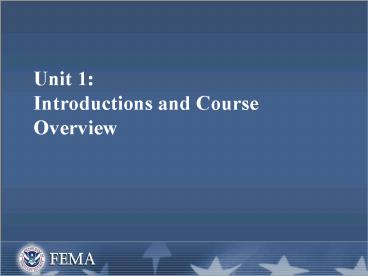Unit 1: Introductions and Course Overview - PowerPoint PPT Presentation
1 / 24
Title:
Unit 1: Introductions and Course Overview
Description:
Cell phones and pagers. Unit 1: Introductions and Course Overview. Introductions. Instructors ... Facilitate logistical support and resource tracking. ... – PowerPoint PPT presentation
Number of Views:44
Avg rating:3.0/5.0
Title: Unit 1: Introductions and Course Overview
1
Unit 1 Introductions and Course Overview
2
Administrative Information
- Hours
- Evacuation routes and fire exits
- Restrooms
- Smoking policy
- Breaks and lunch
- Cell phones and pagers
3
Introductions
- Instructors
- Students
- Name and organization
- Experience with emergency or incident response
using MAC Systems - One special issue about MAC Systems that you
would like to be able to resolve
4
Unit 1 Objectives
- Define multiagency coordination at the local,
State, and Federal levels of government. - Describe the difference between command and
coordination. - Explain the role of Multiagency Coordination
(MAC) Systems in the National Incident Management
System (NIMS) and the National Response Plan
(NRP).
5
Course Introduction
National Incident Management System (NIMS)
http//www.fema.gov/emergency/nims
6
Course Objectives (1 of 2)
- Define multiagency coordination at the local,
State, and Federal levels of government. - Identify each agency involved in incident
management activities to ensure that appropriate
situational awareness and resource status
information is shared through multiagency
coordination. - Identify typical priorities established between
elements of the Multiagency Coordination System.
7
Course Objectives (2 of 2)
- Define key terms related to Multiagency
Coordination Systems. - Describe the process of acquiring and allocating
resources required by incident management
personnel related to the entire Multiagency
Coordination System. - Identify typical future resource requirements for
the entire Multiagency Coordination System. - Identify potential coordination and policy issues
arising from an incident relative to the entire
Multiagency Coordination System.
8
Video Presentation Part 1
- The National Preparedness Goal
- A Culture of Preparedness
9
Video Presentation Part 2
- What Are Multiagency Coordination Systems?
10
Multiagency Coordination Systems
Facilities
Equipment
Personnel
Procedures
Communications
11
MAC Systems Functions (1 of 3)
What is the difference between command and
coordination?
12
MAC Systems Functions (2 of 3)
What are the primary functions of Multiagency
Coordination Systems?
13
MAC Systems Functions (3 of 3)
- The functions of the Multiagency Coordination
System are to - Support incident management policies and
priorities. - Facilitate logistical support and resource
tracking. - Inform resource allocation decisions using
incident management priorities. - Coordinate incident-related information.
- Coordinate and resolve interagency and
intergovernmental issues regarding incident
management policies, priorities, and strategies.
14
MAC Systems Elements (1 of 2)
What are the elements of Multiagency Coordination
Systems?
15
MAC Systems Elements (2 of 2)
- System elements
- Emergency Operations Centers (EOCs)
- Multiagency Coordination Entities
- On-Scene Command Structures
- Resource Centers
- Dispatch Centers
16
A System . . . Not a Facility
17
Multiagency Coordination Simple to Complex
- The complexity of the MAC System is dependent on
the type, size, complexity, and probable duration
of incident operations.
18
Multiagency Coordination Systems
How do Multiagency Coordination Systems help meet
the National Preparedness Goal?
19
National Preparedness Goal
- To engage Federal, State, local, and tribal
entities, their private and nongovernmental
partners, and the general public to achieve and
sustain risk-based target levels of capability to
prevent, protect against, respond to, and recover
from major events to minimize the impact on
lives, property, and the economy.
20
Operational Priorities
- Operational priorities involve minimizing the
impact of an incident on - Lives.
- Property.
- The economy.
21
Activity 1.1 MAC System Development (1 of 2)
- Purpose The purpose of this activity is to
illustrate how MAC Systems develop based on
incident needs. - Instructions Follow the steps below to
complete this activity - 1. Work in small groups as assigned by
the instructor to complete this activity. - 2. Read the case study. Then work in your groups
to answer the questions on the next visual.
22
Activity 1.1 MAC System Development (2 of 2)
- Instructions (Continued)
- How did the elements and functions of the MAC
System described in the case study contribute to
an effective incident response? - What characteristics does your MAC System have in
common with the system described in the case
study? - 3. Be prepared to discuss your groups
responses with the class. - You will have 60 minutes to complete this
activity.
23
Summary and Transition (1 of 2)
- Multiagency Coordination Systems are a
combination of - Facilities.
- Equipment.
- Personnel.
- Procedures.
- Communications.
24
Summary and Transition (2 of 2)
- Multiagency Coordination Systems
- Support incident management policies and
priorities. - Facilitate logistics support and resource
tracking. - Inform resource allocation decisions using
incident management priorities. - Coordinate incident-related information.
- Coordinate and resolve interagency and
intergovernmental issues regarding incident
management policies, priorities, and strategies.































